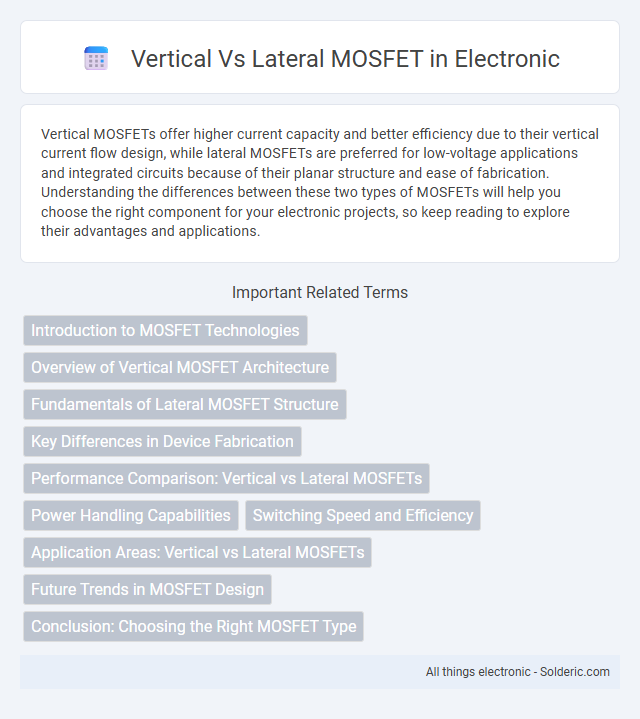Vertical MOSFETs offer higher current capacity and better efficiency due to their vertical current flow design, while lateral MOSFETs are preferred for low-voltage applications and integrated circuits because of their planar structure and ease of fabrication. Understanding the differences between these two types of MOSFETs will help you choose the right component for your electronic projects, so keep reading to explore their advantages and applications.
Comparison Table
| Feature | Vertical MOSFET | Lateral MOSFET |
|---|---|---|
| Current Flow Direction | Vertical (drain to source through substrate) | Lateral (drain to source on the surface) |
| Breakdown Voltage | High (suitable for high-voltage applications) | Lower (limited by lateral structure) |
| On-Resistance (RDS(on)) | Low (due to vertical conduction path) | Higher (surface conduction increases resistance) |
| Application | Power electronics, high-current devices | Low-power analog and RF circuits |
| Chip Area Efficiency | High (compact vertical design) | Lower (larger area for similar current) |
| Thermal Performance | Better heat dissipation via substrate | Less efficient thermal conduction |
| Manufacturing Complexity | Higher (complex substrate doping) | Lower (standard planar processing) |
Introduction to MOSFET Technologies
Vertical MOSFETs feature current flow perpendicular to the substrate, enabling higher current capacity and better thermal management, ideal for power applications. Lateral MOSFETs conduct current parallel to the substrate surface, offering superior switching speed and integration with other IC components, commonly used in signal processing. Understanding these fundamental structural differences is crucial for optimizing device performance in power electronics and integrated circuits.
Overview of Vertical MOSFET Architecture
Vertical MOSFET architecture features current flow perpendicular to the device surface, allowing high current density and superior breakdown voltage. This design enables efficient heat dissipation and compact cell layout, making it ideal for high-power applications. Your choice in semiconductor devices can benefit from the robustness and performance advantages offered by vertical MOSFETs.
Fundamentals of Lateral MOSFET Structure
Lateral MOSFETs feature a planar structure where current flows parallel to the silicon wafer surface, enabling easier integration with peripheral circuitry in CMOS processes. Their fundamental design includes source, drain, and gate terminals aligned on the same surface, allowing compact layouts and improved device isolation. This configuration supports low-voltage applications with reduced parasitic capacitances and enhanced switching speeds compared to vertical counterparts.
Key Differences in Device Fabrication
Vertical MOSFETs feature current flow perpendicular to the semiconductor surface, requiring complex epitaxial layer growth and deep trench formations during device fabrication. Lateral MOSFETs conduct current parallel to the surface, enabling simpler planar processing with shallow junctions and standard photolithography techniques. Your choice impacts fabrication complexity, device scalability, and performance parameters.
Performance Comparison: Vertical vs Lateral MOSFETs
Vertical MOSFETs exhibit superior current handling capability and lower on-resistance (R_DS(on)) due to their vertical current flow through the semiconductor substrate, making them ideal for high-power applications. Lateral MOSFETs, with planar current flow, offer better ease of integration in standard CMOS processes and superior switching speeds but generally suffer from higher on-resistance and lower voltage handling. The performance trade-off hinges on application needs: vertical MOSFETs excel in power efficiency and thermal management, while lateral devices benefit from high-frequency operation and integration density.
Power Handling Capabilities
Vertical MOSFETs typically offer superior power handling capabilities due to their structure, allowing current to flow through the thickness of the semiconductor and enabling higher voltage blocking and current conduction. Lateral MOSFETs, designed with surface channel current flow, generally handle lower power levels and are more suited for low-voltage, signal-level applications. The vertical architecture's reduced on-resistance and better heat dissipation make it ideal for high-power applications such as power supplies and motor drives.
Switching Speed and Efficiency
Vertical MOSFETs generally offer higher current capacity and lower on-resistance, enhancing overall efficiency in power switching applications. Lateral MOSFETs provide faster switching speeds due to shorter channel lengths and reduced parasitic capacitances, making them ideal for high-frequency circuits. Selecting the appropriate MOSFET type depends on Your specific needs for balancing speed and efficiency in device performance.
Application Areas: Vertical vs Lateral MOSFETs
Vertical MOSFETs are widely used in power electronics and high-current applications such as motor drives, power supplies, and voltage regulators due to their ability to handle large currents and high voltages efficiently. Lateral MOSFETs are preferred in low-voltage analog and RF circuits, including CMOS integrated circuits and signal processing, because of their ease of integration with other planar devices on the same chip. Your choice between vertical and lateral MOSFETs will depend on the specific application requirements, such as power handling capacity and integration needs.
Future Trends in MOSFET Design
Future trends in MOSFET design emphasize vertical architectures for enhanced current density and scaling advantages, crucial for advanced power electronics and high-frequency applications. Lateral MOSFETs continue to evolve with innovations in gate dielectrics and channel materials, targeting improved switching speeds and reduced on-resistance for integrated circuits. Emerging technologies like GaN and SiC integration further push the boundaries of vertical versus lateral MOSFET performance in efficiency and thermal management.
Conclusion: Choosing the Right MOSFET Type
Vertical MOSFETs offer higher current capacity and lower on-resistance, making them ideal for power devices and high-voltage applications. Lateral MOSFETs provide better switching speed and ease of integration in ICs, suited for low-voltage and high-frequency circuits. Selecting the right MOSFET depends on balancing performance requirements, voltage ratings, and device size for the specific application.
Vertical vs Lateral MOSFET Infographic

 solderic.com
solderic.com